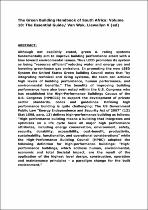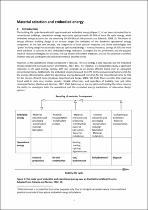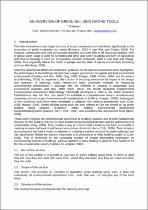JavaScript is disabled for your browser. Some features of this site may not work without it.
- ResearchSpace
- →
- Research Publications/Outputs
- →
- Books
- →
- View Item
| dc.contributor.author |
Van Wyk, Llewellyn V

|
|
| dc.date.accessioned | 2017-06-07T08:06:11Z | |
| dc.date.available | 2017-06-07T08:06:11Z | |
| dc.date.issued | 2016-12 | |
| dc.identifier.citation | Van Wyk, L.V. (ed). 2016. The Green Building Handbook of South Africa: Volume 10: The Essential Guide. Cape Town: Alive2green. | en_US |
| dc.identifier.isbn | 978 0 620 45240 3 | |
| dc.identifier.uri | http://alive2green.com/wp-content/uploads/2016/07/GBH-2016-UPDATED_.pdf | |
| dc.identifier.uri | http://hdl.handle.net/10204/9264 | |
| dc.description | Copyright: 2016 Alive2green. Due to copyright restrictions, the attached PDF file only contains the abstract of the full text item. For access to the full text item, kindly consult the publisher's website. | en_US |
| dc.description.abstract | Although not explicitly stated, green A. rating systems fundamentally aim to improve building performance albeit with a bias toward environmental issues. Thus LEED promotes its system as being "resource efficient"reducing water and energy use and lowering greenhouse gas emissions. In promoting the new LEED System the United States Green Building Council notes that "by integrating technical and living systems, the team can achieve high levels of building performance, human performance, and environmental benefits." The benefits of improving building performance have also been noted within the U.S. Congress who has established the High-Performance Buildings Caucus of the U.S. Congress (HPBCCC) to support the development of private sector standards, codes and guidelines. Defining high performance building is quite challenging: The US Government Public Law "Energy Independence and Security Act of 2007" (121 Stat 1598, para. 12) defines high-performance building as follows: "High-performance building means a building that integrates and optimizes on a life cycle basis all major high performance attributes, including energy conservation, environment, safety, security, durability, accessibility, cost-benefit, productivity, sustainability, functionality, and operational considerations" while the High-Performance Building Council (HPBC) adopted the following definition for high-performance buildings: "High-performance buildings, which address human, environmental, economic and total Societal impact, are the result of the application of the highest level design, construction, operation and maintenance principles - a paradigm change for the built environment." | en_US |
| dc.language.iso | en | en_US |
| dc.publisher | Alive2green | en_US |
| dc.relation.ispartofseries | Worklist;18751 | |
| dc.subject | Green buildings | en_US |
| dc.subject | Green Building Handbook volume 10 | en_US |
| dc.subject | Building performances | en_US |
| dc.subject | Building infrastructures | en_US |
| dc.subject | Sustainable buildings | en_US |
| dc.title | The Green Building Handbook of South Africa: Volume 10: The Essential Guide | en_US |
| dc.type | Book | en_US |
| dc.identifier.apacitation | Van Wyk, L. V. (2016). <i>The Green Building Handbook of South Africa: Volume 10: The Essential Guide</i>. Alive2green. http://hdl.handle.net/10204/9264 | en_ZA |
| dc.identifier.chicagocitation | Van Wyk, Llewellyn V. <i>The Green Building Handbook of South Africa: Volume 10: The Essential Guide</i>. n.p.: Alive2green. 2016. http://hdl.handle.net/10204/9264. | en_ZA |
| dc.identifier.vancouvercitation | Van Wyk LV. The Green Building Handbook of South Africa: Volume 10: The Essential Guide. [place unknown]: Alive2green; 2016.http://hdl.handle.net/10204/9264 | en_ZA |
| dc.identifier.ris | TY - Book AU - Van Wyk, Llewellyn V AB - Although not explicitly stated, green A. rating systems fundamentally aim to improve building performance albeit with a bias toward environmental issues. Thus LEED promotes its system as being "resource efficient"reducing water and energy use and lowering greenhouse gas emissions. In promoting the new LEED System the United States Green Building Council notes that "by integrating technical and living systems, the team can achieve high levels of building performance, human performance, and environmental benefits." The benefits of improving building performance have also been noted within the U.S. Congress who has established the High-Performance Buildings Caucus of the U.S. Congress (HPBCCC) to support the development of private sector standards, codes and guidelines. Defining high performance building is quite challenging: The US Government Public Law "Energy Independence and Security Act of 2007" (121 Stat 1598, para. 12) defines high-performance building as follows: "High-performance building means a building that integrates and optimizes on a life cycle basis all major high performance attributes, including energy conservation, environment, safety, security, durability, accessibility, cost-benefit, productivity, sustainability, functionality, and operational considerations" while the High-Performance Building Council (HPBC) adopted the following definition for high-performance buildings: "High-performance buildings, which address human, environmental, economic and total Societal impact, are the result of the application of the highest level design, construction, operation and maintenance principles - a paradigm change for the built environment." DA - 2016-12 DB - ResearchSpace DP - CSIR KW - Green buildings KW - Green Building Handbook volume 10 KW - Building performances KW - Building infrastructures KW - Sustainable buildings LK - https://researchspace.csir.co.za PY - 2016 SM - 978 0 620 45240 3 T1 - The Green Building Handbook of South Africa: Volume 10: The Essential Guide TI - The Green Building Handbook of South Africa: Volume 10: The Essential Guide UR - http://hdl.handle.net/10204/9264 ER - | en_ZA |









